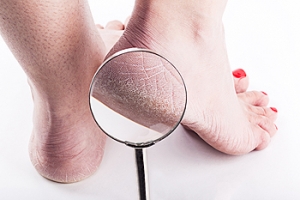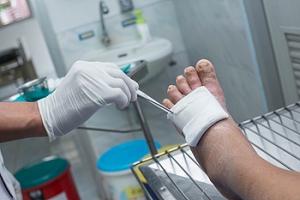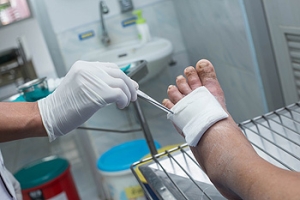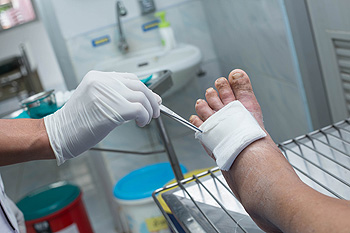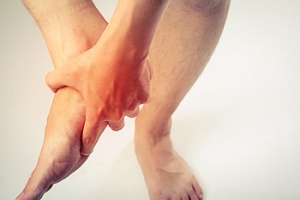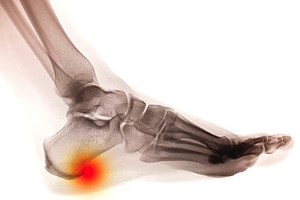Items filtered by date: November 2019
What Causes Cracked Heels?
Research has indicated that cracked heels affect more than fifty percent of the world's population. This condition may be a result of wearing shoes that have an open back, or from standing for long periods of time throughout the day. The skin may lose its elasticity, and can gradually develop deep cracks, which are also known as fissures. It may be beneficial to stretch the Achilles tendon before the day begins. This may help to ease the amount of weight the heels absorb as walking occurs. Patients may find relief when their feet are washed and thoroughly dried, followed by applying a good moisturizer. Additionally, cracked heels may be prevented when shoes are worn that offer adequate support for the heels. If you have any questions about effective remedies for this condition, it is suggested that you seek the counsel of a podiatrist.
If the skin on your feet starts to crack, you may want to see a podiatrist to find treatment. If you have any concerns, contact Dr. Kenneth Donovan from Advanced Care Foot and Ankle. Our doctor can provide the care you need to keep you pain-free and on your feet.
Cracked Heels
It is important to moisturize your cracked heels in order to prevent pain, bleeding, and infection. The reason cracked heels form is because the skin on the foot is too dry to support the immense pressure placed on them. When the foot expands, the dry skin on the foot begins to split.
Ways to Help Heal Them
- Invest in a good foot cream
- Try Using Petroleum Jelly
- Ease up on Soaps
- Drink Plenty of Water
Ways to Prevent Cracked Heels
- Moisturize After Showering
- Skip a Shower
- Keep Shower Water Lukewarm
- Don’t Scrub Your Feet
If you are unsure how to proceed in treating cracked heels, seek guidance from a podiatrist.
If you have any questions, please feel free to contact one of our offices located in Warren, Livingston, and Toms River, NJ . We offer the newest diagnostic and treatment technologies for all your foot care needs.
What Causes Cracked Heels?
 Research has indicated that cracked heels affect more than fifty percent of the world's population. This condition may be a result of wearing shoes that have an open back, or from standing for long periods of time throughout the day. The skin may lose its elasticity, and can gradually develop deep cracks, which are also known as fissures. It may be beneficial to stretch the Achilles tendon before the day begins. This may help to ease the amount of weight the heels absorb as walking occurs. Patients may find relief when their feet are washed and thoroughly dried, followed by applying a good moisturizer. Additionally, cracked heels may be prevented when shoes are worn that offer adequate support for the heels. If you have any questions about effective remedies for this condition, it is suggested that you seek the counsel of a podiatrist.
Research has indicated that cracked heels affect more than fifty percent of the world's population. This condition may be a result of wearing shoes that have an open back, or from standing for long periods of time throughout the day. The skin may lose its elasticity, and can gradually develop deep cracks, which are also known as fissures. It may be beneficial to stretch the Achilles tendon before the day begins. This may help to ease the amount of weight the heels absorb as walking occurs. Patients may find relief when their feet are washed and thoroughly dried, followed by applying a good moisturizer. Additionally, cracked heels may be prevented when shoes are worn that offer adequate support for the heels. If you have any questions about effective remedies for this condition, it is suggested that you seek the counsel of a podiatrist.
If the skin on your feet starts to crack, you may want to see a podiatrist to find treatment. If you have any concerns, contact Dr. Kenneth Donovan from Advanced Care Foot and Ankle. Our doctor can provide the care you need to keep you pain-free and on your feet.
Cracked Heels
It is important to moisturize your cracked heels in order to prevent pain, bleeding, and infection. The reason cracked heels form is because the skin on the foot is too dry to support the immense pressure placed on them. When the foot expands, the dry skin on the foot begins to split.
Ways to Help Heal Them
- Invest in a good foot cream
- Try Using Petroleum Jelly
- Ease up on Soaps
- Drink Plenty of Water
Ways to Prevent Cracked Heels
- Moisturize After Showering
- Skip a Shower
- Keep Shower Water Lukewarm
- Don’t Scrub Your Feet
If you are unsure how to proceed in treating cracked heels, seek guidance from a podiatrist. Your doctor will help you with any questions or information you may need.
If you have any questions, please feel free to contact one of our offices located in Warren, Livingston, and Toms River, NJ . We offer the newest diagnostic and treatment technologies for all your foot care needs.
Diabetic Foot Ulcers Require Prompt Care
A common type of wound that many diabetic patients contend with is known as a foot ulcer. It typically develops on the sole of the foot, and can become infected if it is not promptly treated. It can form as a result of neuropathy that may exist in the foot. This can make it difficult to feel any cuts and bruises on the bottom of the foot, which may lead to a foot ulcer. Research has indicated the first step in treating this type of wound is to implement methods that can prevent infection. These can be obtained by maintaining normal glucose levels, and keeping the wound clean and properly bandaged. Many patients are advised to keep the weight off of the affected foot, and this can help to accelerate the healing process. If you are afflicted with a diabetic foot ulcer, it is strongly advised that you are under the care of a podiatrist.
Wound care is an important part in dealing with diabetes. If you have diabetes and a foot wound or would like more information about wound care for diabetics, consult with Dr. Kenneth Donovan from Advanced Care Foot and Ankle. Our doctor will assess your condition and provide you with quality foot and ankle treatment.
What Is Wound Care?
Wound care is the practice of taking proper care of a wound. This can range from the smallest to the largest of wounds. While everyone can benefit from proper wound care, it is much more important for diabetics. Diabetics often suffer from poor blood circulation which causes wounds to heal much slower than they would in a non-diabetic.
What Is the Importance of Wound Care?
While it may not seem apparent with small ulcers on the foot, for diabetics, any size ulcer can become infected. Diabetics often also suffer from neuropathy, or nerve loss. This means they might not even feel when they have an ulcer on their foot. If the wound becomes severely infected, amputation may be necessary. Therefore, it is of the upmost importance to properly care for any and all foot wounds.
How to Care for Wounds
The best way to care for foot wounds is to prevent them. For diabetics, this means daily inspections of the feet for any signs of abnormalities or ulcers. It is also recommended to see a podiatrist several times a year for a foot inspection. If you do have an ulcer, run the wound under water to clear dirt from the wound; then apply antibiotic ointment to the wound and cover with a bandage. Bandages should be changed daily and keeping pressure off the wound is smart. It is advised to see a podiatrist, who can keep an eye on it.
If you have any questions, please feel free to contact one of our offices located in Warren, Livingston, and Toms River, NJ . We offer the newest diagnostic and treatment technologies for all your foot care needs.
Diabetic Foot Ulcers Require Prompt Care
A common type of wound that many diabetic patients contend with is known as a foot ulcer. It typically develops on the sole of the foot, and can become infected if it is not promptly treated. It can form as a result of neuropathy that may exist in the foot. This can make it difficult to feel any cuts and bruises on the bottom of the foot, which may lead to a foot ulcer. Research has indicated the first step in treating this type of wound is to implement methods that can prevent infection. These can be obtained by maintaining normal glucose levels, and keeping the wound clean and properly bandaged. Many patients are advised to keep the weight off of the affected foot, and this can help to accelerate the healing process. If you are afflicted with a diabetic foot ulcer, it is strongly advised that you are under the care of a podiatrist.
Wound care is an important part in dealing with diabetes. If you have diabetes and a foot wound or would like more information about wound care for diabetics, consult with Dr. Kenneth Donovan from Advanced Care Foot and Ankle. Our doctor will assess your condition and provide you with quality foot and ankle treatment.
What Is Wound Care?
Wound care is the practice of taking proper care of a wound. This can range from the smallest to the largest of wounds. While everyone can benefit from proper wound care, it is much more important for diabetics. Diabetics often suffer from poor blood circulation which causes wounds to heal much slower than they would in a non-diabetic.
What Is the Importance of Wound Care?
While it may not seem apparent with small ulcers on the foot, for diabetics, any size ulcer can become infected. Diabetics often also suffer from neuropathy, or nerve loss. This means they might not even feel when they have an ulcer on their foot. If the wound becomes severely infected, amputation may be necessary. Therefore, it is of the upmost importance to properly care for any and all foot wounds.
How to Care for Wounds
The best way to care for foot wounds is to prevent them. For diabetics, this means daily inspections of the feet for any signs of abnormalities or ulcers. It is also recommended to see a podiatrist several times a year for a foot inspection. If you do have an ulcer, run the wound under water to clear dirt from the wound; then apply antibiotic ointment to the wound and cover with a bandage. Bandages should be changed daily and keeping pressure off the wound is smart. It is advised to see a podiatrist, who can keep an eye on it.
If you have any questions, please feel free to contact one of our offices located in Warren, Livingston, and Toms River, NJ . We offer the newest diagnostic and treatment technologies for all your foot care needs.
Wounds That Don’t Heal Need to Be Checked
Your feet are covered most of the day. If you're diabetic, periodic screening is important for good health. Numbness is often a sign of diabetic foot and can mask a sore or wound.
Common Types of Foot Pain
The foot is comprised of numerous bones, tendons, and ligaments, and general foot pain may be felt as a result of body weight the feet endure on a daily basis. There are specific types of foot injuries that affect many patients. These can consist of tendon injuries, fractures, and sprains. Additionally, corns are caused by excess friction from wearing shoes and socks that do not fit properly, and may produce considerable pain and discomfort. A common type of toe pain may be related to ingrown toenails. This occurs when the nail on the big toe grows into the surrounding skin. If you are afflicted with any type of foot pain, it is strongly advised that you consult with a podiatrist who can offer the best remedy for the type of foot pain you may have.
Foot Pain
Foot pain can be extremely painful and debilitating. If you have a foot pain, consult with Dr. Kenneth Donovan from Advanced Care Foot and Ankle. Our doctor will assess your condition and provide you with quality foot and ankle treatment.
Causes
Foot pain is a very broad condition that could be caused by one or more ailments. The most common include:
- Bunions
- Hammertoes
- Plantar Fasciitis
- Bone Spurs
- Corns
- Tarsal Tunnel Syndrome
- Ingrown Toenails
- Arthritis (such as Gout, Rheumatoid, and Osteoarthritis)
- Flat Feet
- Injury (from stress fractures, broken toe, foot, ankle, Achilles tendon ruptures, and sprains)
- And more
Diagnosis
To figure out the cause of foot pain, podiatrists utilize several different methods. This can range from simple visual inspections and sensation tests to X-rays and MRI scans. Prior medical history, family medical history, and any recent physical traumatic events will all be taken into consideration for a proper diagnosis.
Treatment
Treatment depends upon the cause of the foot pain. Whether it is resting, staying off the foot, or having surgery; podiatrists have a number of treatment options available for foot pain.
If you have any questions, please feel free to contact one of our offices located in Warren, Livingston, and Toms River, NJ . We offer the newest diagnostic and treatment technologies for all your foot care needs.
Common Types of Foot Pain
 The foot is comprised of numerous bones, tendons, and ligaments, and general foot pain may be felt as a result of body weight the feet endure on a daily basis. There are specific types of foot injuries that affect many patients. These can consist of tendon injuries, fractures, and sprains. Additionally, corns are caused by excess friction from wearing shoes and socks that do not fit properly, and may produce considerable pain and discomfort. A common type of toe pain may be related to ingrown toenails. This occurs when the nail on the big toe grows into the surrounding skin. If you are afflicted with any type of foot pain, it is strongly advised that you consult with a podiatrist who can offer the best remedy for the type of foot pain you may have.
The foot is comprised of numerous bones, tendons, and ligaments, and general foot pain may be felt as a result of body weight the feet endure on a daily basis. There are specific types of foot injuries that affect many patients. These can consist of tendon injuries, fractures, and sprains. Additionally, corns are caused by excess friction from wearing shoes and socks that do not fit properly, and may produce considerable pain and discomfort. A common type of toe pain may be related to ingrown toenails. This occurs when the nail on the big toe grows into the surrounding skin. If you are afflicted with any type of foot pain, it is strongly advised that you consult with a podiatrist who can offer the best remedy for the type of foot pain you may have.
Foot Pain
Foot pain can be extremely painful and debilitating. If you have a foot pain, consult with Dr. Kenneth Donovan from Advanced Care Foot and Ankle. Our doctor will assess your condition and provide you with quality foot and ankle treatment.
Causes
Foot pain is a very broad condition that could be caused by one or more ailments. The most common include:
- Bunions
- Hammertoes
- Plantar Fasciitis
- Bone Spurs
- Corns
- Tarsal Tunnel Syndrome
- Ingrown Toenails
- Arthritis (such as Gout, Rheumatoid, and Osteoarthritis)
- Flat Feet
- Injury (from stress fractures, broken toe, foot, ankle, Achilles tendon ruptures, and sprains)
- And more
Diagnosis
To figure out the cause of foot pain, podiatrists utilize several different methods. This can range from simple visual inspections and sensation tests to X-rays and MRI scans. Prior medical history, family medical history, and any recent physical traumatic events will all be taken into consideration for a proper diagnosis.
Treatment
Treatment depends upon the cause of the foot pain. Whether it is resting, staying off the foot, or having surgery; podiatrists have a number of treatment options available for foot pain.
If you have any questions, please feel free to contact one of our offices located in Warren, Livingston, and Toms River, NJ . We offer the newest diagnostic and treatment technologies for all your foot care needs.
How Do Heel Spurs Develop?
One of the most noticeable symptoms of a heel spur is pain in the heel and surrounding areas. It can occur as a result of walking and standing on hard surfaces, wearing new shoes that do not fit correctly, or after training for a specific sport. It can develop from consistent pressure that is put on the heel, and may cause a small bony protrusion to form on the heel bone. The symptoms that many people experience is pain on the bottom of the foot while pursuing activities that require walking and standing. If a heel spur is left untreated, pain and discomfort may be felt even when the foot is resting. Moderate relief may be found if a protective pad is worn in the shoe. Additionally, it may be helpful to stretch the heel frequently. This can be accomplished by standing on a step, and gently raising and lowering the heel. Severe heel spurs can be debilitating. If you are suffering from this ailment, it is strongly advised that you consult with a podiatrist who can properly treat this condition.
Heel spurs can be incredibly painful and sometimes may make you unable to participate in physical activities. To get medical care for your heel spurs, contact Dr. Kenneth Donovan from Advanced Care Foot and Ankle. Our doctor will do everything possible to treat your condition.
Heels Spurs
Heel spurs are formed by calcium deposits on the back of the foot where the heel is. This can also be caused by small fragments of bone breaking off one section of the foot, attaching onto the back of the foot. Heel spurs can also be bone growth on the back of the foot and may grow in the direction of the arch of the foot.
Older individuals usually suffer from heel spurs and pain sometimes intensifies with age. One of the main condition's spurs are related to is plantar fasciitis.
Pain
The pain associated with spurs is often because of weight placed on the feet. When someone is walking, their entire weight is concentrated on the feet. Bone spurs then have the tendency to affect other bones and tissues around the foot. As the pain continues, the feet will become tender and sensitive over time.
Treatments
There are many ways to treat heel spurs. If one is suffering from heel spurs in conjunction with pain, there are several methods for healing. Medication, surgery, and herbal care are some options.
If you have any questions feel free to contact one of our offices located in Warren, Livingston, and Toms River, NJ . We offer the latest in diagnostic and treatment technology to meet your needs.
How Do Heel Spurs Develop?
 One of the most noticeable symptoms of a heel spur is pain in the heel and surrounding areas. It can occur as a result of walking and standing on hard surfaces, wearing new shoes that do not fit correctly, or after training for a specific sport. It can develop from consistent pressure that is put on the heel, and may cause a small bony protrusion to form on the heel bone. The symptoms that many people experience is pain on the bottom of the foot while pursuing activities that require walking and standing. If a heel spur is left untreated, pain and discomfort may be felt even when the foot is resting. Moderate relief may be found if a protective pad is worn in the shoe. Additionally, it may be helpful to stretch the heel frequently. This can be accomplished by standing on a step, and gently raising and lowering the heel. Severe heel spurs can be debilitating. If you are suffering from this ailment, it is strongly advised that you consult with a podiatrist who can properly treat this condition.
One of the most noticeable symptoms of a heel spur is pain in the heel and surrounding areas. It can occur as a result of walking and standing on hard surfaces, wearing new shoes that do not fit correctly, or after training for a specific sport. It can develop from consistent pressure that is put on the heel, and may cause a small bony protrusion to form on the heel bone. The symptoms that many people experience is pain on the bottom of the foot while pursuing activities that require walking and standing. If a heel spur is left untreated, pain and discomfort may be felt even when the foot is resting. Moderate relief may be found if a protective pad is worn in the shoe. Additionally, it may be helpful to stretch the heel frequently. This can be accomplished by standing on a step, and gently raising and lowering the heel. Severe heel spurs can be debilitating. If you are suffering from this ailment, it is strongly advised that you consult with a podiatrist who can properly treat this condition.
Heel spurs can be incredibly painful and sometimes may make you unable to participate in physical activities. To get medical care for your heel spurs, contact Dr. Kenneth Donovan from Advanced Care Foot and Ankle. Our doctor will do everything possible to treat your condition.
Heels Spurs
Heel spurs are formed by calcium deposits on the back of the foot where the heel is. This can also be caused by small fragments of bone breaking off one section of the foot, attaching onto the back of the foot. Heel spurs can also be bone growth on the back of the foot and may grow in the direction of the arch of the foot.
Older individuals usually suffer from heel spurs and pain sometimes intensifies with age. One of the main condition's spurs are related to is plantar fasciitis.
Pain
The pain associated with spurs is often because of weight placed on the feet. When someone is walking, their entire weight is concentrated on the feet. Bone spurs then have the tendency to affect other bones and tissues around the foot. As the pain continues, the feet will become tender and sensitive over time.
Treatments
There are many ways to treat heel spurs. If one is suffering from heel spurs in conjunction with pain, there are several methods for healing. Medication, surgery, and herbal care are some options.
If you have any questions feel free to contact one of our offices located in Warren, Livingston, and Toms River, NJ . We offer the latest in diagnostic and treatment technology to meet your needs.
